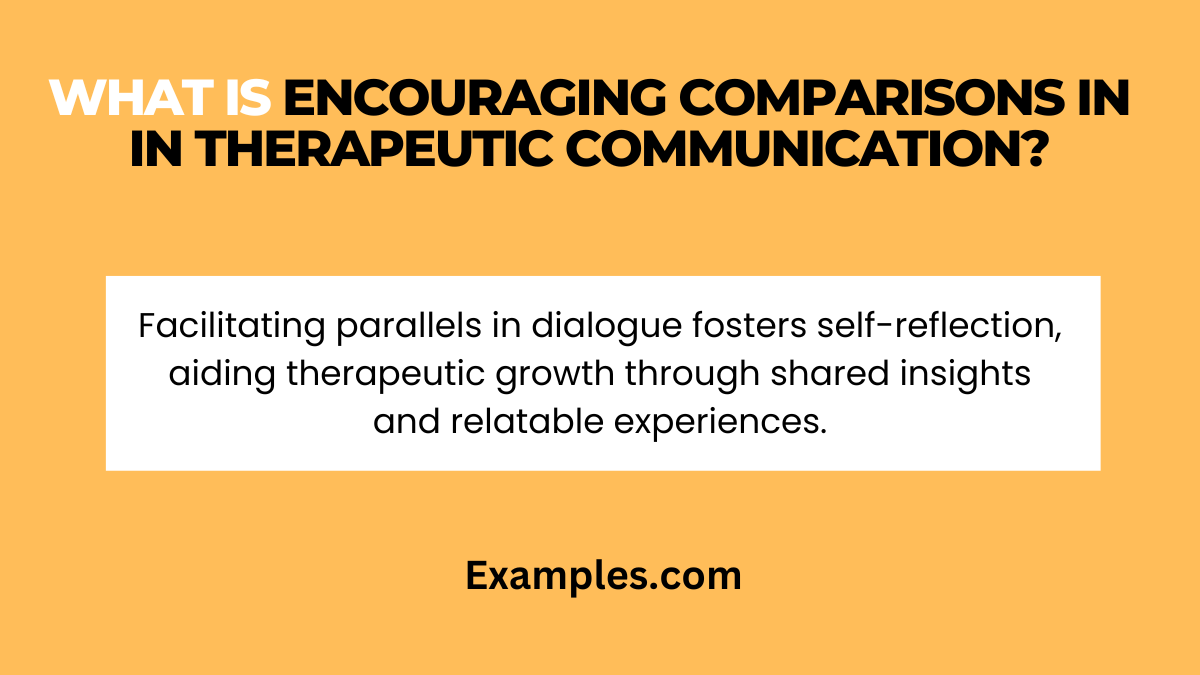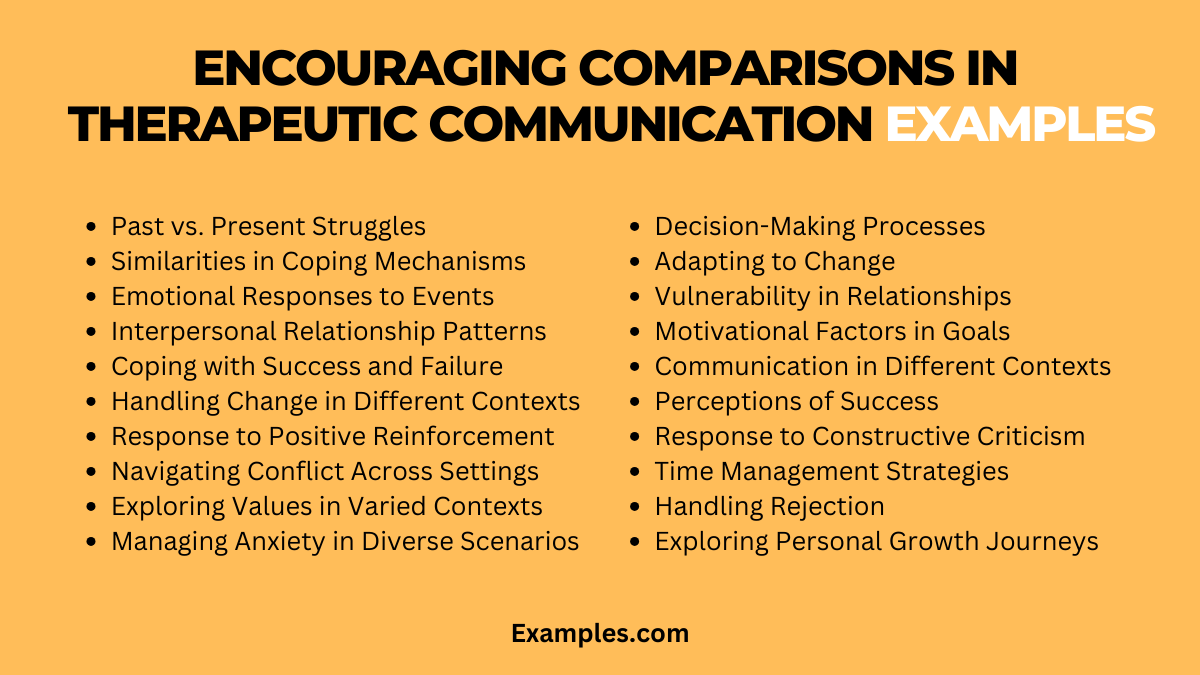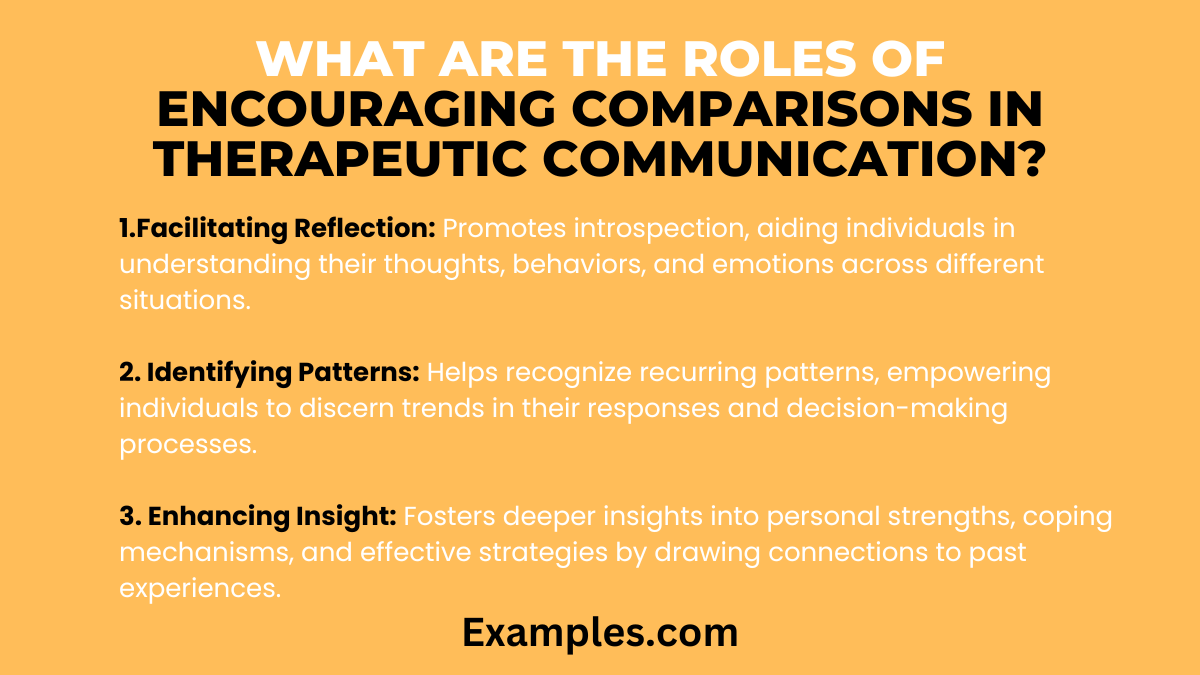Encouraging Comparisons in Therapeutic Communication
Enhance therapeutic connections through Encouraging Comparisons! This comprehensive guide unveils effective strategies and communication examples, empowering practitioners to navigate sensitive topics with finesse. Elevate your therapeutic skills by embracing the art of Encouraging Comparisons, fostering understanding and growth in clients. Dive into real-world scenarios and enrich your toolbox with invaluable insights to enhance the impact of your therapeutic communication. Communication examples take center stage in this insightful exploration of Encouraging Comparisons.
What is Encouraging Comparisons in Therapeutic Communication?

Encouraging Comparisons is a therapeutic communication technique that prompts individuals to reflect on similarities and differences, fostering deeper self-awareness. By inviting clients to draw parallels between experiences, emotions, or situations, therapists encourage introspection and exploration. This method facilitates personal insights, aiding in the therapeutic process by promoting understanding and self-discovery. The goal is to gently guide individuals toward recognizing patterns, making connections, and gaining clarity through thoughtful comparisons.
20 Encouraging Comparisons in Therapeutic Communication Examples

Therapists can employ the technique of encouraging comparisons to deepen self-awareness and enhance therapeutic outcomes. By drawing connections between experiences, clients gain valuable insights. Explore the following examples:
- Past vs. Present Struggles: “Reflect on how you tackled challenges in the past versus your current approach.”
- Similarities in Coping Mechanisms: “Identify similarities in how you cope with stress at work and in personal relationships.”
- Emotional Responses to Events: “Compare emotional responses to past and present significant life events for better understanding.”
- Interpersonal Relationship Patterns: “Examine similarities in your patterns of interaction across various relationships.”
- Coping with Success and Failure: “Explore how you navigate both success and failure; identify common threads.”
- Handling Change in Different Contexts: “Discuss how you adapted to change in professional settings versus personal life.”
- Response to Positive Reinforcement: “Consider how positive feedback impacts you professionally versus personally.”
- Navigating Conflict Across Settings: “Draw parallels in how you navigate conflicts at work and within your family dynamics.”
- Exploring Values in Varied Contexts: “Compare the expression of your values in different areas of your life.”
- Managing Anxiety in Diverse Scenarios: “Reflect on similarities in your coping mechanisms when facing anxiety-inducing situations.”
- Decision-Making Processes: “Examine your decision-making process at work and in personal matters for commonalities.”
- Adapting to Change: “Explore how you’ve adapted to changes in routine across different life domains.”
- Expressing Vulnerability in Relationships: “Draw comparisons in how you express vulnerability in friendships and romantic relationships.”
- Motivational Factors in Goals: “Identify common motivators influencing your goals in various aspects of life.”
- Communication Styles in Different Contexts: “Compare your communication style at work versus how you communicate within your family.”
- Perceptions of Success: “Explore how your perception of success aligns or differs in personal and professional realms.”
- Response to Constructive Criticism: “Consider similarities in how you respond to feedback at work and in personal growth.”
- Time Management Strategies: “Examine commonalities in how you manage time across different areas of your life.”
- Handling Rejection: “Compare your emotional response to rejection in social settings and professional contexts.”
- Exploring Personal Growth Journeys: “Reflect on your journey of personal growth and how it parallels or diverges in various aspects.”
Encouraging Comparisons in Therapeutic Communication Examples for Nurses
In nursing, encouraging comparisons fosters insightful reflections. Nurses can support patients by prompting comparisons related to their health and emotional well-being.
- Adapting to Medication Changes Nurse: “Reflect on how you adapted to medication changes previously and explore adjustments needed now.”
- Comparing Coping Mechanisms Nurse: “Identify similarities in how you coped with past health challenges and apply effective strategies.”
- Emotional Responses to Treatment Nurse: “Compare emotional responses to different stages of treatment; recognize patterns for emotional support.”
- Navigating Lifestyle Adjustments Nurse: “Explore similarities in lifestyle adjustments made in the past for health improvements and apply learnings.”
- Progress Monitoring Through Comparisons Nurse: “Encourage comparisons in health progress over time, fostering motivation and goal-oriented care.”
Encouraging Comparisons in Therapeutic Communication Examples for Patient Care
In patient care, encouraging comparisons aids in holistic well-being. By guiding patients to draw connections, healthcare providers enhance understanding and collaboration.
- Self-Management Insights Healthcare Provider: “Reflect on past self-management strategies; let’s identify effective approaches for ongoing care.”
- Comparing Coping Strategies Healthcare Provider: “Explore similarities in coping mechanisms during health challenges to empower current coping efforts.”
- Emotional Resilience Over Time Healthcare Provider: “Reflect on emotional resilience during previous health episodes; apply insights to current emotional well-being.”
- Adjusting Daily Routines Healthcare Provider: “Draw parallels in how daily routines positively influenced health before; integrate beneficial habits now.”
- Treatment Adherence Reflection Healthcare Provider: “Compare experiences with treatment adherence; let’s tailor a plan that aligns with your lifestyle.”
How do you Encourage Comparisons in Therapeutic Communication?
Encouraging comparisons involves skillful communication techniques to prompt individuals to reflect on past experiences, behaviors, or emotions. Therapists or healthcare providers can employ the following strategies:
- Open-Ended Questions: Frame questions that invite detailed responses, encouraging individuals to draw connections between past and present situations.
- Reflective Listening: Actively listen to verbal and non-verbal cues, validating the individual’s experiences and fostering a comfortable space for comparisons.
- Visual Aids: Utilize charts, diagrams, or visual representations to facilitate discussions and highlight parallels in different scenarios.
- Narrative Techniques: Encourage storytelling to unveil personal narratives, facilitating the identification of patterns and comparisons.
- Empathy: Display empathy to create a supportive atmosphere, allowing individuals to explore emotions and experiences openly.
What are the Roles of Encouraging Comparisons in Therapeutic Communication?

Encouraging comparisons plays crucial roles in therapeutic communication, contributing to the overall effectiveness of the interaction:
- Facilitating Reflection: Promotes introspection, aiding individuals in understanding their thoughts, behaviors, and emotions across different situations.
- Identifying Patterns: Helps recognize recurring patterns, empowering individuals to discern trends in their responses and decision-making processes.
- Enhancing Insight: Fosters deeper insights into personal strengths, coping mechanisms, and effective strategies by drawing connections to past experiences.
- Promoting Goal Setting: Allows for informed goal-setting based on past successes, providing a foundation for achievable and tailored objectives.
- Strengthening Therapeutic Alliance: Builds trust and rapport between the individual and the therapist, creating a collaborative environment for effective communication.
What are the Benefits of Encouraging Comparisons in Therapeutic Communication?
The practice of encouraging comparisons yields numerous advantages, enriching the therapeutic process and promoting positive outcomes:
- Improved Self-Awareness: Individuals gain a clearer understanding of their behaviors, emotions, and responses, fostering self-awareness.
- Enhanced Problem-Solving: Identifying similarities and differences empowers individuals to apply effective problem-solving strategies to current challenges.
- Tailored Interventions: Facilitates the customization of therapeutic interventions based on insights gained from past experiences, optimizing effectiveness.
- Increased Motivation: Recognizing past successes instills a sense of accomplishment and motivation, supporting individuals in their therapeutic journey.
- Effective Coping Skills: Encouraging comparisons allows individuals to draw on past coping mechanisms, equipping them with valuable skills to navigate present situations.
In conclusion, encouraging comparisons in therapeutic communication emerges as a powerful tool, fostering self-awareness, insight, and effective problem-solving. By weaving narratives and drawing parallels between experiences, individuals can tailor interventions, enhance coping skills, and embark on a transformative journey. This comprehensive guide equips healthcare professionals with strategies to enrich therapeutic interactions and promote positive outcomes.



